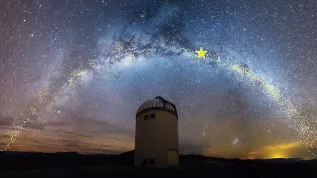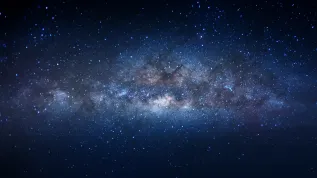
Scientific world is still celebrating the detection of gravitational waves. Meanwhile, Polish-American team led by Prof. Krzysztof Belczyński predicted six years ago that the first source of the waves would be a collision of black holes and not neutron stars.
Scientists announced the observation of gravitational waves on February 11 this year. Historic observation was made on September 14, 2015, when two American LIGO detectors located 3 thousand km away from each other almost at the same time recorded the signal of gravitational waves. It originated from the collision of two black holes, respectively 36 and 29 solar masses, which is equal to the total mass of 65 solar masses.
While the scientific world is celebrating detection of gravitational waves for several days now, already in 2010 Polish-American team led by Prof. Krzysztof Belczyński showed that the first detection of gravitational waves will be possible after a collision of two black holes, and not - as expected - two neutron stars. Researchers also calculated that the sum of the masses of the two black holes in this detection would be between 20 and 80 solar masses. Such were the results of calculations made by Dr. Michał Dominik, who defended his doctoral thesis in 2014 at the Astronomical Observatory of the University of Warsaw was under the guidance of Prof. Belczyński.
"Gravitational waves are a consequence of the equations of general relativity given by Albert Einstein in 1916. Since the 1960s, scientists have been trying to >>see<< gravitational waves and confirm Einstein\'s theory" - explained Prof. Krzysztof Belczyński from the University of Warsaw.
The first significant step was made in the 1970s by American physicists Russell A. Hulse and Joseph H. Taylor. They discovered the existence of the first system of two neutron stars, which were slowly approaching each other. A result of their collision - in about 300 million years - will be a strong emission of gravitational waves. For this discovery they received the Nobel Prize in 1993.
Astronomers dealing with this issue began to suspect, however, that there may be many more such objects. "So many, that a collision of two or more neutron stars may occur every year. You only need to reach deep enough into space to observe these collisions" - explained Prof. Belczyński. This was the purpose of the LIGO gravitational observatory, built in the 1990s. However, small sensitivity of the first observations did not allow to reach deep enough into the Universe to observe gravitational waves. LIGO was in fact sensitive to the detection of collisions of two neutron stars only up to 18 Mpc (unit of distance used in astronomy - PAP).
Scientists have suspected that not only neutron stars would generate such waves, but also black holes. Strong gravitational waves should form, in particular, as a result of the collision of a black hole with neutron star, or the collision of two black holes. "And while modern astronomy has evidence of the existence of about 20 black holes, until now there was no evidence of the existence of systems consisting of a neutron star and a black hole, or systems of two black holes. Hence it was not expected that collisions of black holes can be the first observed sources of gravitational waves" - explained Prof. Belczyński.
A breakthrough in understanding the formation of black holes came in 2010. Theoretical studies on the evolution of the most massive stars allowed Polish-American team led by Prof. Belczyński to present a new theory of the formation of black holes.
In the first step, the researchers showed that black holes can have a mass up to 80 solar masses, not just 10-20 masses as previously thought. "This result had a huge impact on the assessment of the chances of detection of gravitational waves. The more massive black holes are, the stronger the gravitational waves produced by their collision and the easier it is to observe them" - explained Prof. Belczyński.
In the second step, researchers showed that previous estimates of the amount of collisions of black holes in the universe were completely incorrect. "All the works on the creation of systems of two black holes had been based on the evolution of stars in our galaxy. They are stars with a high content of heavy elements - metals. The evolution of these stars, and in particular their rapid expansion and increase in size immediately after burning off hydrogen, means that these stars rarely produce systems of two colliding black holes" - explained the professor.
Prof. Belczyński’s team noticed that, firstly, most of the stars in the early stages of the history of the universe had very small amounts of heavy elements, and secondly, the evolution of these stars leads to a very efficient formation of systems with black holes. In practice, these ancient systems of black holes that formed billions of years ago, collide in the last 1-2 billion years, which is within the visibility range of the LIGO observatory. Their number not only exceeds the number of collisions of neutron stars, but it is several hundred times greater than the number of collisions of black holes in galaxies such as the Milky Way. The team formulated a very specific hypothesis: "if instruments such as LIGO reach a sensitivity of 50-100 Mpc, the first detection of gravitational waves should occur. It will be a collision of two black holes".
In the third step, these theoretical predictions found the first observational support. Scientists demonstrated the accuracy of their theoretical work on the example of the so-called mass gap. "Since the early 1990s scientists had been puzzled by the lack of neutron stars and black holes in the range of 2 to 5 solar masses. In 2012 - based on our models - we showed that the +mass gap+ was a natural consequence of the speed and power of supernova explosions" - explained the scientist.
In 2010-2015, LIGO observatory was significantly upgraded in terms of sensitivity and observation range. In the fall of 2015 years it resumed operations with increased sensitivity with a range of 70 Mpc. Research carried out in the upgraded observatory allowed for the first detection of gravitational waves and confirmed the predictions of the Polish-American team.
Prof. Belczyński’s team members included Tomasz Bulik, Michał Dominik, Grzegorz Wiktorowicz and Wojciech Gladysz. Research was co-financed by the National Science Centre and the Foundation for Polish Science.
15 Polish scientists working in the POLGRAW group significantly contributed to the first observation of gravitational waves. The project - in addition to researchers from the University of Warsaw - involved researchers from the Institute of Mathematics PAS, Nicolaus Copernicus Astronomical Center PAS, National Centre for Nuclear Research, as well as universities in Białystok, Wrocław, Zielona Góra and Nicolaus Copernicus University in Toruń.
Professor Belczyński and his team have already prepared an astrophysical interpretation of the first detection of gravitational waves. The paper will be reviewed in a specialist international journal. More on the theoretical work of the team here.
PAP - Science and Scholarship in Poland
ekr/ agt/ mrt/
tr. RL













